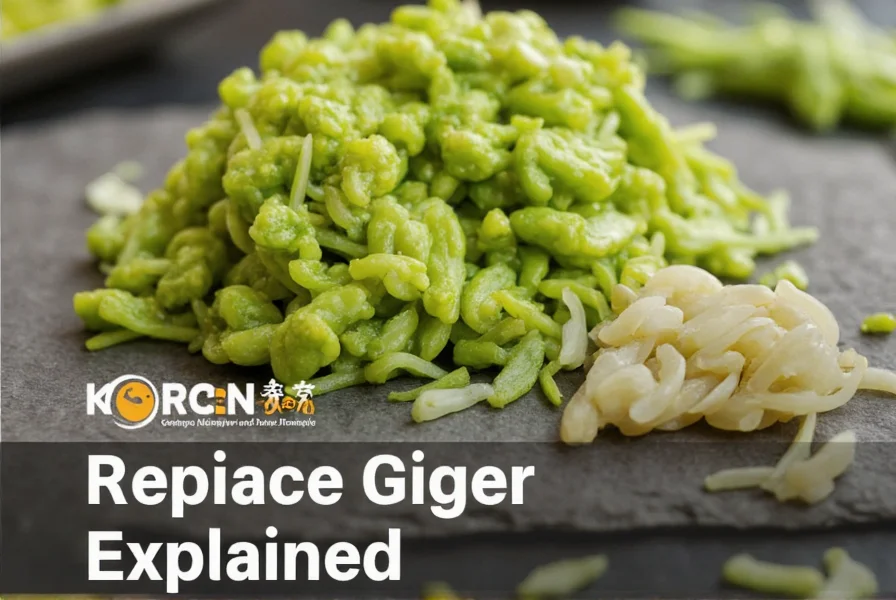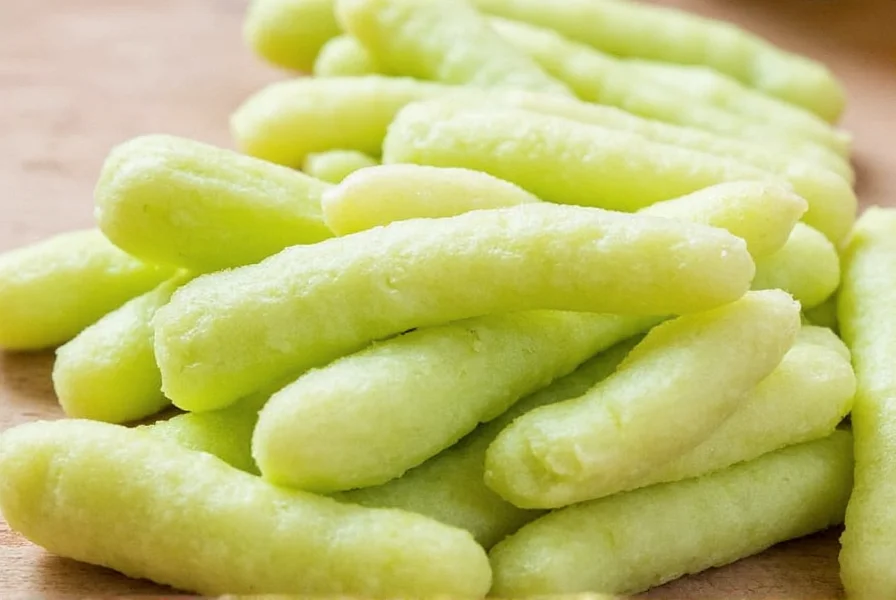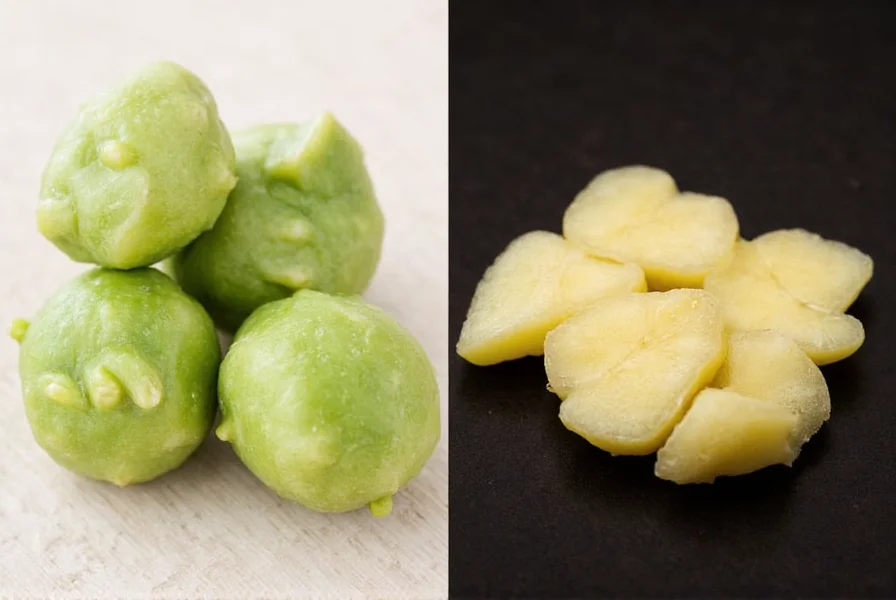Many people mistakenly believe that the green paste served as "wasabi" in most restaurants is authentic wasabi, but it's typically a mixture of horseradish, mustard, and food coloring. True wasabi is rare and expensive due to its specific growing requirements, while ginger is widely available worldwide. This comprehensive guide explores the botanical differences, flavor profiles, culinary applications, and health properties of these two distinctive ingredients.
Botanical Background and Physical Characteristics
Wasabi (Wasabia japonica) belongs to the Brassicaceae family, which includes horseradish and mustard. It grows naturally along mountain stream beds in Japan and requires specific cool, shaded, and moist conditions. Fresh wasabi rhizome has a pale green color with a smooth texture and grows to about 6-12 inches long.
Ginger (Zingiber officinale) is part of the Zingiberaceae family, related to turmeric and cardamom. It's a tropical plant with knobby, beige-colored rhizomes that grow horizontally underground. Ginger rhizomes typically have a rough, bark-like exterior with a yellow or white interior.
| Characteristic | Wasabi | Ginger |
|---|---|---|
| Botanical Family | Brassicaceae (mustard family) | Zingiberaceae |
| Native Region | Japan | Southeast Asia |
| Heat Compound | Allyl isothiocyanate | Gingerol |
| Heat Duration | Short-lived (30 seconds) | Longer-lasting (minutes) |
| Flavor Profile | Sharp, clean, slightly sweet | Warm, spicy-sweet, citrusy |
Understanding the Heat Profiles
The most significant difference between wasabi and ginger lies in their heat characteristics. Wasabi's heat comes from allyl isothiocyanate, which is volatile and dissipates quickly—typically within 30 seconds. This compound stimulates the nasal passages more than the tongue, creating that distinctive "upward" heat sensation. Authentic wasabi paste should be prepared fresh by grating the rhizome, as the compounds begin to degrade within minutes.
Ginger's heat comes primarily from gingerol, which transforms into the more pungent shogaol when dried or cooked. Unlike wasabi's fleeting heat, ginger provides a warming sensation that lingers on the tongue and throat. The heat level varies depending on the ginger's age—older ginger tends to be hotter and more fibrous than younger, "spring" ginger.
Culinary Applications and Traditional Uses
Authentic Japanese cuisine uses fresh wasabi primarily as a condiment for sushi and sashimi, where its antimicrobial properties help offset potential food safety concerns with raw fish. High-end sushi restaurants grate fresh wasabi rhizome tableside for optimal flavor. The traditional pairing with soy sauce involves mixing a small amount directly into the soy rather than creating a wasabi mound on the sushi.
Ginger appears in cuisines worldwide with diverse applications. In Asian cooking, it's used fresh in stir-fries, marinades, and soups. In Western baking, dried ginger features prominently in cookies and spice cakes. Ginger also serves as a key ingredient in beverages like ginger ale, ginger beer, and traditional medicinal teas. The versatility of ginger extends to both sweet and savory applications, unlike wasabi which remains predominantly a savory condiment.
Health Properties and Scientific Research
Both wasabi and ginger offer potential health benefits supported by scientific research, though their bioactive compounds differ significantly. Wasabi contains isothiocyanates with demonstrated anti-inflammatory and antimicrobial properties. Studies suggest these compounds may help prevent blood clots and have potential cancer-fighting properties, though more research is needed.
Ginger's gingerols show more extensively documented health benefits, particularly for digestive health. Clinical trials support ginger's effectiveness in reducing nausea (including morning sickness and chemotherapy-induced nausea), decreasing muscle pain, and lowering inflammation markers. The Arthritis Foundation recommends ginger as a complementary approach for osteoarthritis management.
Substitution Guide: When Can You Swap Wasabi and Ginger?
While wasabi and ginger both provide heat, they're not direct substitutes due to their distinct flavor profiles. In most cases, substituting one for the other will significantly alter the dish's intended flavor. However, there are limited scenarios where substitution might work:
- For sushi: Horseradish-based "wasabi" can substitute for real wasabi, but ginger won't work
- In marinades: Fresh ginger can sometimes replace wasabi in non-traditional Asian fusion recipes
- For heat: A small amount of wasabi paste might substitute for fresh ginger in dressings where color isn't critical
When substituting, start with much smaller quantities of wasabi than ginger due to its more intense initial heat. Remember that wasabi's heat dissipates quickly while ginger's builds gradually.
Storage and Preparation Tips
Fresh wasabi rhizome is extremely perishable and should be stored wrapped in damp paper towels inside an airtight container in the refrigerator. Even under ideal conditions, it lasts only 1-2 weeks. For longer storage, wasabi can be frozen whole but loses some flavor complexity when thawed.
Fresh ginger keeps well for several weeks when stored in a paper bag in the refrigerator's vegetable drawer. For extended storage, freeze ginger whole and grate it frozen as needed. To prepare either ingredient, use a fine grater or traditional sharkskin grater (for wasabi) to maximize surface area and flavor release.

Identifying Authentic Products
Due to wasabi's rarity and cost, most products labeled as wasabi outside Japan contain primarily horseradish. To identify authentic wasabi products:
- Check ingredients: Real wasabi should list Wasabia japonica as the primary ingredient
- Color: Authentic wasabi paste is pale green, not bright green
- Texture: Freshly grated wasabi has a slightly fibrous texture
- Price: Genuine wasabi products cost significantly more than imitations
For ginger, look for firm, smooth rhizomes without wrinkles or soft spots. Organic ginger often has more intense flavor than conventionally grown varieties.

Conclusion
Understanding the differences between wasabi and ginger enhances your culinary capabilities and helps you make informed choices when selecting ingredients. While both provide distinctive heat, their botanical origins, flavor compounds, and culinary applications differ significantly. Real wasabi remains a specialty ingredient best appreciated in traditional Japanese contexts, while ginger's versatility makes it a kitchen staple worldwide. By recognizing their unique properties, you can use each ingredient to its full potential in appropriate dishes.
Frequently Asked Questions
Is the wasabi served in most restaurants real wasabi?
No, approximately 95% of "wasabi" served outside Japan is actually a mixture of horseradish, mustard powder, and green food coloring. True wasabi (Wasabia japonica) is difficult to cultivate and expensive, making it rare in most restaurants. Authentic wasabi has a more complex flavor and shorter-lived heat compared to the horseradish-based substitute.
Can I substitute ginger for wasabi in sushi?
No, ginger and wasabi serve different purposes in sushi preparation. Ginger (gari) is traditionally served as a palate cleanser between different types of sushi, while wasabi provides a complementary heat to the fish. Their flavor profiles are too distinct for substitution in traditional sushi service. If authentic wasabi is unavailable, horseradish makes a closer substitute than ginger.
Which has more health benefits, wasabi or ginger?
Both offer health benefits but with different strengths. Ginger has more extensively researched benefits, particularly for digestive issues, nausea reduction, and inflammation. Wasabi contains unique isothiocyanates with potential antimicrobial and anti-inflammatory properties, but research is less comprehensive. For general health purposes, ginger has broader applications, while wasabi's benefits are more specialized.
Why does wasabi heat feel different from ginger heat?
Wasabi's heat comes from volatile allyl isothiocyanate compounds that primarily stimulate the nasal passages, creating that distinctive "upward" sensation that dissipates quickly. Ginger's heat comes from gingerol compounds that activate receptors on the tongue and throat, producing a warming sensation that builds gradually and lasts longer. This fundamental chemical difference explains why wasabi's heat feels sharp but brief while ginger's warmth lingers.











 浙公网安备
33010002000092号
浙公网安备
33010002000092号 浙B2-20120091-4
浙B2-20120091-4